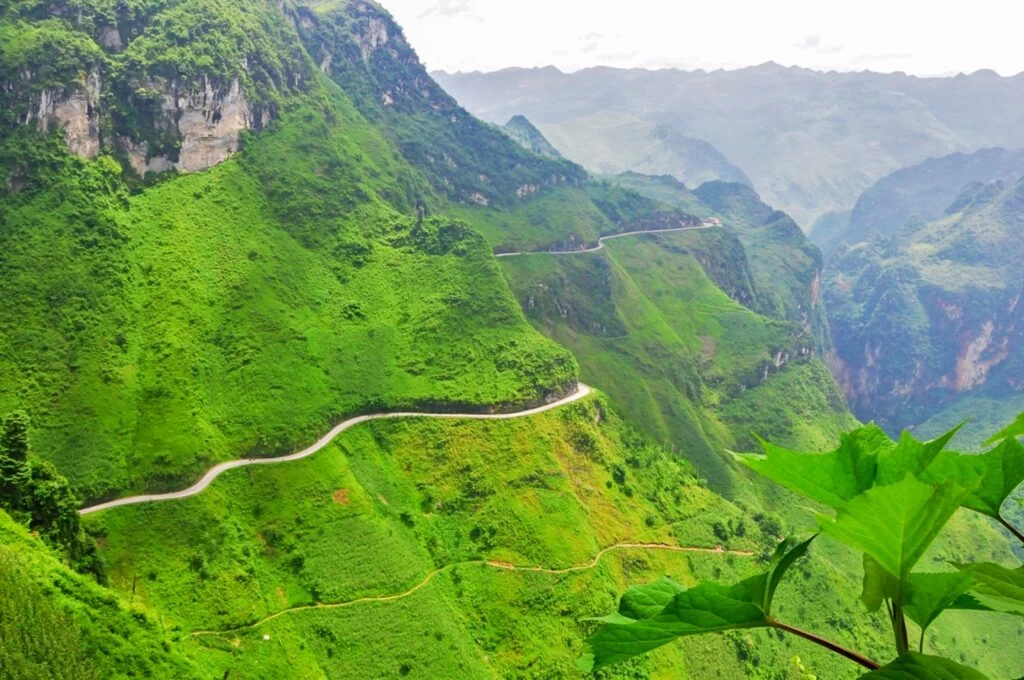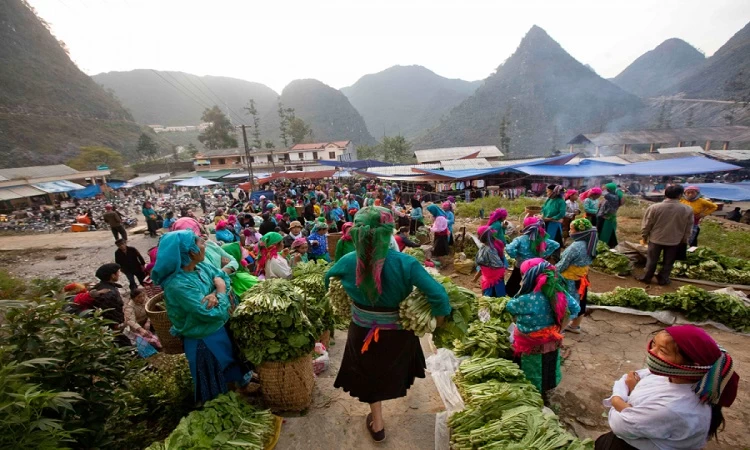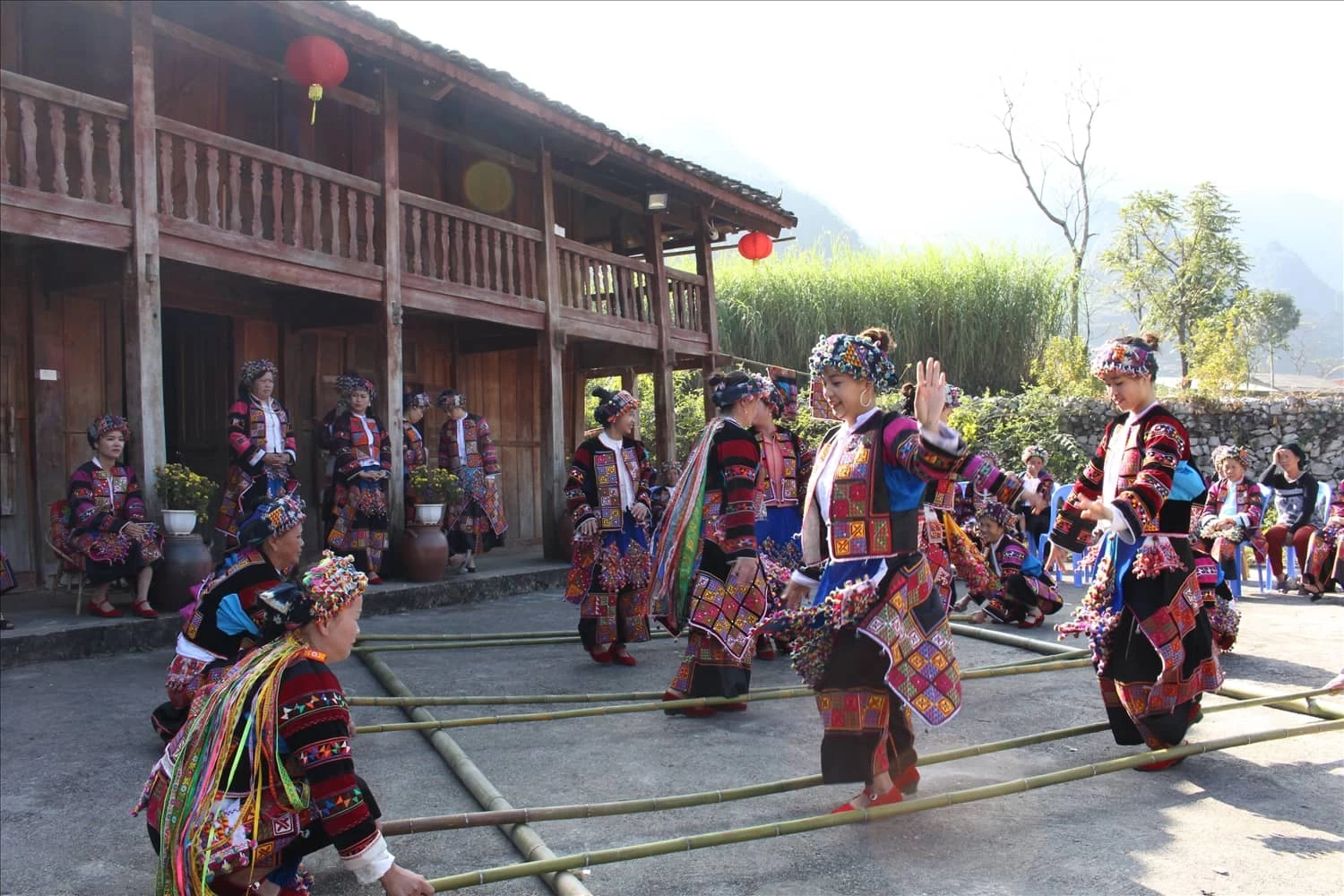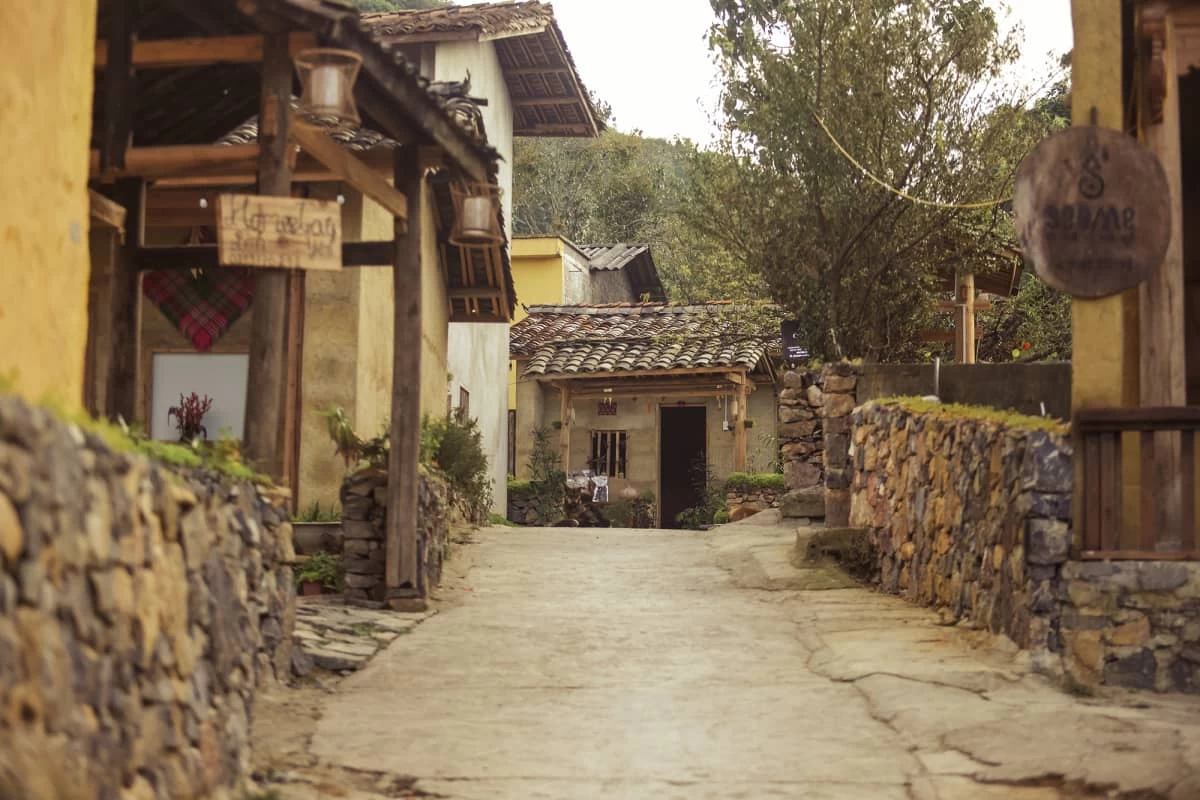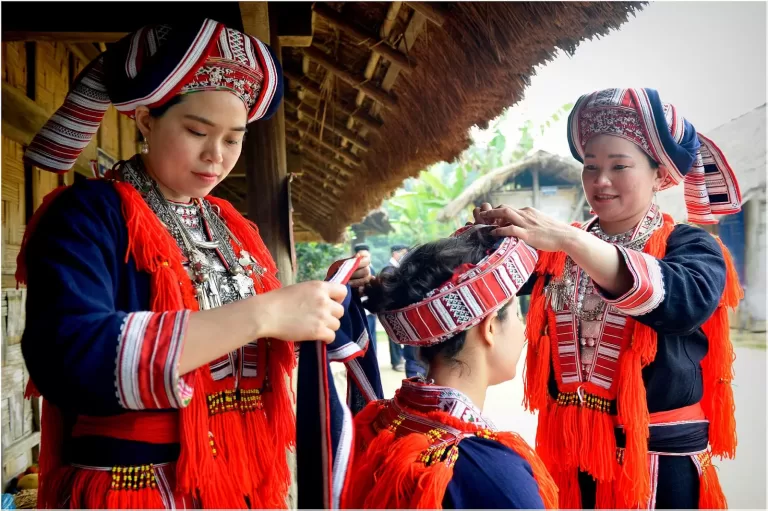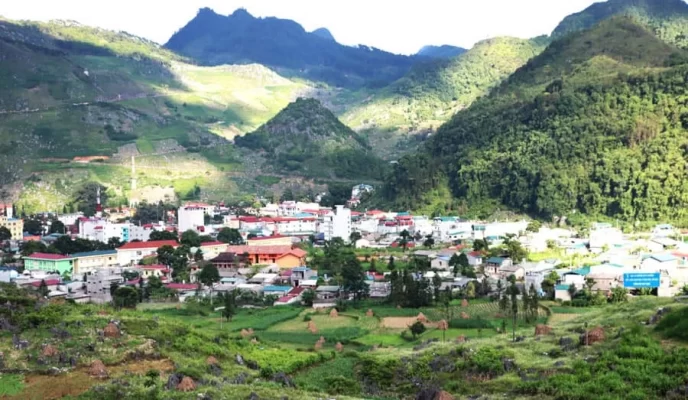
Let’s explore the beauty of Meo Vac Town
Discover the enchanting Meo Vac Town in Vietnam’s Ha Giang Province, a hidden gem rich in cultural heritage and stunning landscapes. Explore must-see attractions like Ma Pi Leng Pass and Meo Vac Market, and immerse yourself in the vibrant local culture and traditions of ethnic minorities. Plan your unforgettable adventure to Meo Vac Town today with Ula Travel!
I. Introduction to Meo Vac Town
1. Where is Meo Vac Town?
Meo Vac Town is situated in Ha Giang Province, in the far north of Vietnam. Nestled amidst the rugged landscapes of the Dong Van Karst Plateau, this remote town is bordered by steep limestone mountains and deep valleys. Its location provides a breathtaking backdrop and a sense of isolation that adds to its charm and allure.
2. Highlights of Meo Vac Town
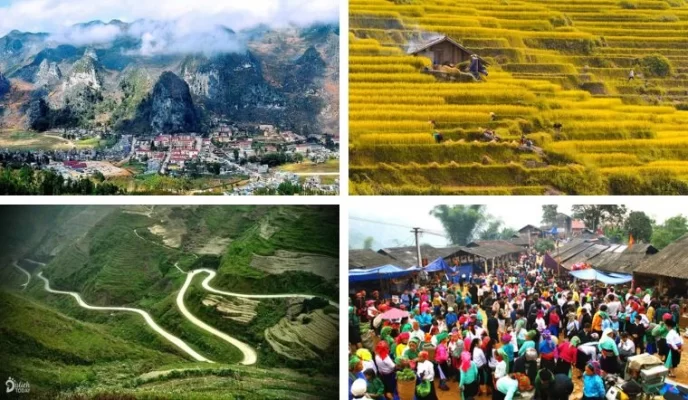
Visitors can experience the many different beauties of Meo Vac Town
- Scenic Beauty: The town is surrounded by dramatic landscapes, including the famous Ma Pi Leng Pass, one of the most spectacular mountain passes in Vietnam.
- Cultural Diversity: Meo Vac is home to various ethnic groups, including the H’mong, Dao, Tay, and Lo Lo people. Each group has its own distinct customs, traditional attire, and way of life, providing visitors with a rich tapestry of cultural experiences.
- Traditional Architecture: The town features traditional stilt houses and stone-walled homes that reflect the architectural styles of the local ethnic communities. Walking through the town, visitors can admire the unique construction techniques and the use of natural materials that blend seamlessly with the surrounding environment.
- Adventure Opportunities: Meo Vac is a hub for outdoor enthusiasts seeking adventure. The rugged terrain offers excellent trekking and hiking routes, while the winding roads are popular among motorbike riders exploring the Ha Giang Loop.
II. Getting to Meo Vac Town
Traveling from Hanoi to Meo Vac Town is an adventure that offers stunning views and a glimpse into the heart of Northern Vietnam. Here are the most popular ways to make the journey:
Public Transportation
- Buses: The journey typically takes around 8–10 hours, depending on traffic and weather conditions. Buses often leave from My Dinh or Giap Bat bus stations in Hanoi.
- Minibuses: Minibuses or “limousine” services are a popular choice for travelers seeking a more comfortable ride. These vehicles are smaller, typically nine-seaters, and offer a more personalized experience.
Private Transportation
For those who prefer to travel at their own pace, driving a car or riding a motorbike offers unparalleled flexibility and the opportunity to explore the stunning landscapes of northern Vietnam.
- Route 1: Depart from Hanoi – Highway 32 – Son Tay – Trung Ha Bridge – Co Tiet – Phong Chau Bridge (cross Phong Châu Bridge and then turn left) – follow the Thao River to Phu Tho Town – Đoan Hung, then go to Tuyen Quang – follow Highway 2 to Ha Giang.
- Route 2: Depart from Hanoi – Vinh Phuc – Viet Tri – Phu Tho – Tuyen Quang – Ha Giang (via Highway 2C and Highway 2, approximately 280 km).
III. Best Time to Visit Meo Vac Town
Meo Vac Town experiences a temperate climate influenced by its elevation. The weather can be broadly categorized into two main seasons: the dry season and the rainy season.
- Dry Season (October to April): This is considered the best time to visit Meo Vac. The weather is generally cool and dry, making it perfect for outdoor activities and exploration.
- Rainy Season (May to September): The rainy season brings frequent and heavy rains, which can lead to landslides and difficult travel conditions.
IV. Best Places to Go in Meo Vac Town
1. Ma Pi Leng Pass
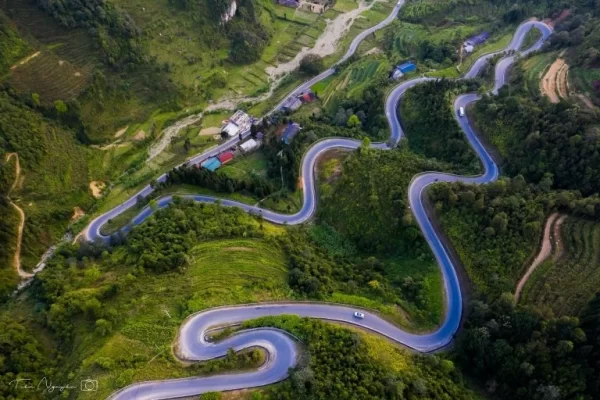
Ma Pi Leng Pass- one of the four great passes of Vietnam
Ma Pi Leng Pass is often referred to as the “King of Passes” in Vietnam. Nestled in the Dong Van Karst Plateau Geopark, a UNESCO Global Geopark, this pass stretches for about 20 kilometers between Dong Van and Meo Vac.
The pass is renowned for its breathtaking scenery, characterized by towering limestone mountains and the deep, winding Nho Que River below. At an elevation of approximately 1,500 meters above sea level, Ma Pi Leng offers one of the most spectacular and dramatic landscapes in Vietnam, making it a must-visit destination for adventurers and nature lovers.

The beauty of Nho Que River captivates tourists
Highlights:
- Panoramic Views: The pass provides panoramic views of the rugged mountains and the Nho Que River canyon. The viewing platform, often called the “Heaven’s Gate,” offers visitors a stunning vantage point to take in the grandeur of the landscape.
- Nho Que River: The Nho Que River, flowing beneath the pass, is a serene and striking contrast to the towering mountains. Its emerald-green waters carve through the karst landscape, creating picturesque scenes.
- Ma Pi Leng Skywalk: The recently constructed Ma Pi Leng Skywalk allows visitors to walk along a narrow path that hugs the cliff edge, providing thrilling views straight down into the canyon below.
- Cultural Encounters: Along the way, travelers can encounter local ethnic minorities, such as the H’Mong people, who inhabit the region. These encounters offer a glimpse into the traditional lifestyles and cultures of the local communities.
- Trekking and cycling: For the more adventurous, trekking and cycling routes along Ma Pi Leng Pass provide a more intimate exploration of the area. These activities allow visitors to experience the natural beauty and tranquility of the landscape up close.
Click here: Ha Giang Tour Package 5D4N
2. Meo Vac Market
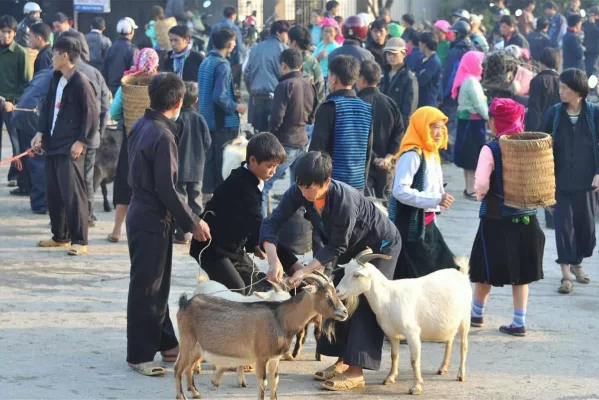
Bustling scene at Meo Vac Market
Meo Vac Market, located in the heart of Meo Vac Town, is a vibrant and bustling hub that offers a unique glimpse into the daily life and culture of the local ethnic communities.
This market operates every Sunday, attracting people from various ethnic groups, such as H’mong, Dao, Tay, and Lo Lo. It’s one of the largest and most well-known markets in the Ha Giang region.
The market is divided into several sections, each dedicated to different types of goods. From fresh produce, livestock, traditional clothing, and handmade crafts to household items, the market is a colorful mosaic of the region’s diverse offerings.
The most intriguing part of the market is the livestock section, where buffaloes, cows, pigs, and chickens are traded in a lively and often noisy atmosphere.
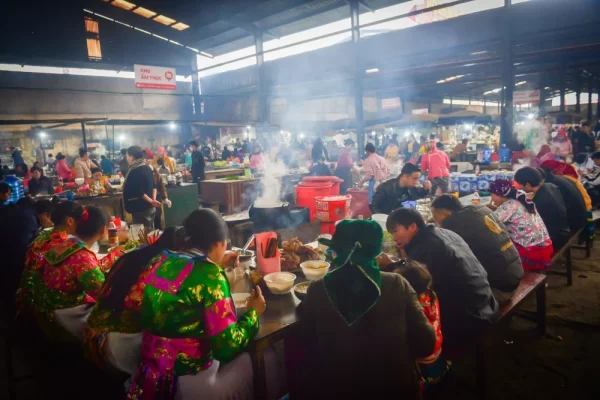
Food court at the market
Experiences:
- Cultural Immersion: Visiting Meo Vac Market is an immersive cultural experience. It’s a place where you can observe and interact with people from various ethnic backgrounds, all dressed in their traditional attire. Each ethnic group has its own distinct clothing, adding to the vibrant and colorful atmosphere of the market.
- Shopping for Handicrafts: The market is a treasure trove for unique souvenirs and traditional handicrafts. You can find beautifully embroidered clothing, handmade jewelry, and intricate woven textiles.
- Tasting Local Delicacies: Food lovers will relish the opportunity to taste local delicacies at the market. Try traditional dishes such as “thang co” (a traditional H’mong soup), “men men” (steamed cornmeal), and various other local snacks. The market food stalls offer an authentic taste of the regional cuisine.
- Learning Traditional Practices: Engage with the locals and learn about their traditional practices and lifestyles. Many of the traders are eager to share stories about their crafts, customs, and the significance of the items they sell. This interaction provides deeper insights into the local culture and traditions.
More details: Ha Giang to Cao Bang Tour
3. Khau Vai Love Market
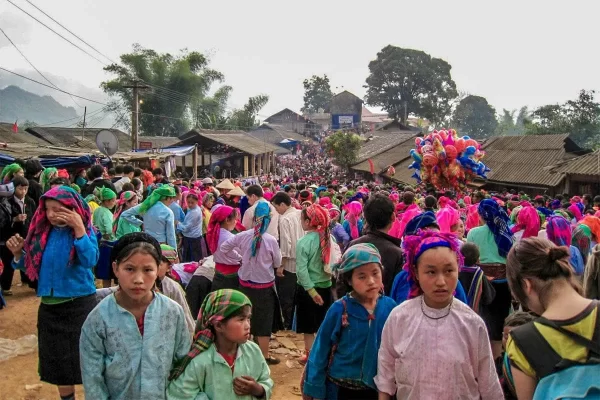
Girls come to Khau Vai Love Market to find love again
Khau Vai Love Market, located in Meo Vac Town, is a unique cultural event celebrated by ethnic minority groups in the northern mountains of Vietnam. Traditionally held on the 27th day of the third lunar month, it serves as a rendezvous for couples who cannot be together due to various circumstances, offering them a chance to meet, reminisce, and cherish their past love.
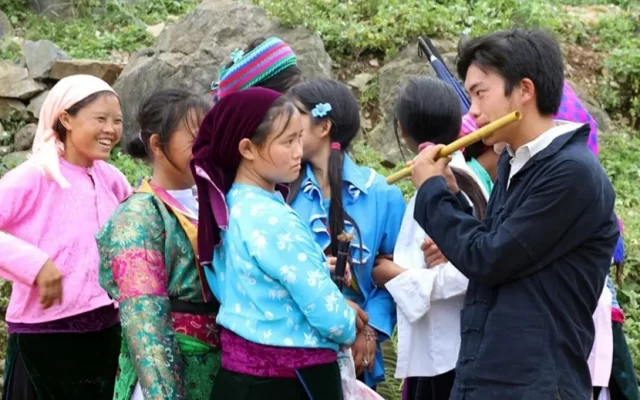
The young man used the flute to express his love
Highlights:
- Cultural Significance: Known as one of the few love markets in the world, Khau Vai Market is steeped in local folklore and romantic legends. It is a testament to the enduring spirit of love and fidelity among the ethnic communities.
- Market Atmosphere: During the festival, the market bustles with activity as local ethnic groups, predominantly H’Mong and Giay people, gather to trade goods and share stories.
- Romantic Traditions: Couples, both young and old, flock to the market to reaffirm their relationships or reminisce about lost loves. The market is a place where emotional reunions take place, often accompanied by heartfelt songs and dances that reflect the region’s rich cultural heritage.
You will be like: Best things to do in Ha Giang
4. Ethnic Cultural Villages in Meo Vac Town
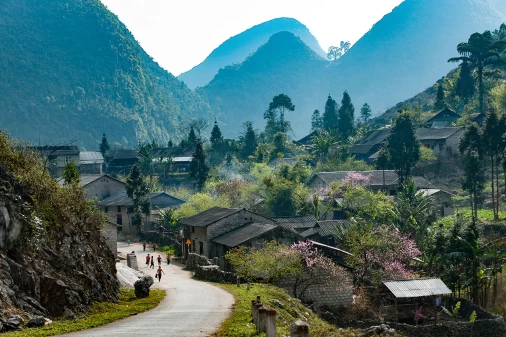
Ethnic Cultural Villages in Meo Vac Town
The ethnic cultural villages in Meo Vac Town are among the most compelling attractions for visitors. These villages offer a deep dive into the rich cultural heritage and traditional lifestyles of various ethnic groups such as the H’Mong, Dao, Tay, and Lo Lo.
Each village showcases unique architectural styles, traditional crafts, and daily practices that have been preserved over generations. The thatched-roof houses, terraced fields, and intricate stone walls reflect the harmony between the people and their natural environment.
Visiting these villages is like stepping back in time, offering a glimpse into the unaltered way of life that has been maintained for centuries.
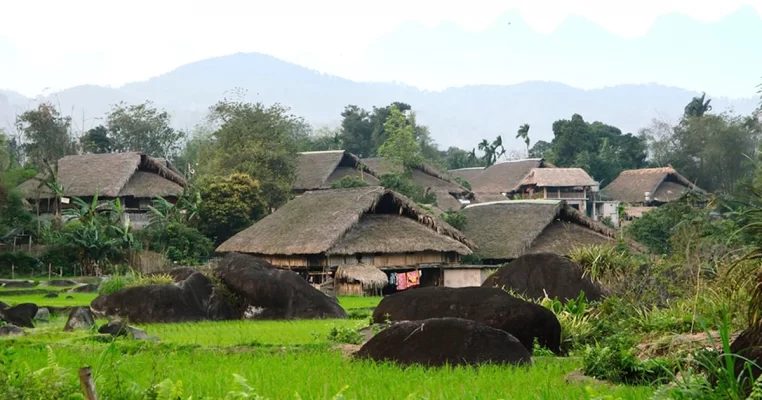
Houses of ethnic minorities
Interacting with Local Communities:
- Engage with local villagers to learn about their customs and traditions.
- Participate in daily activities such as farming, weaving, and cooking traditional meals.
- Listen to stories and legends passed down through generations, gaining insight into the history and culture of the ethnic groups.
Traditional Crafts and Workshops:
- Witness the intricate process of making traditional handicrafts such as textiles, embroidery, and silver jewelry.
- Join workshops where you can try your hand at creating these crafts under the guidance of skilled artisans.
Cultural Performances:
- Enjoy traditional music and dance performances that showcase the vibrant cultural expressions of the ethnic groups.
- Participate in traditional games and activities that are part of village festivals and ceremonies.
Exploring Village Architecture:
- Take guided tours through the villages to appreciate the distinctive architectural styles, from wooden stilt houses to stone houses with thatched roofs.
- Learn about the construction techniques and materials used, which reflect the adaptation to the local environment and climate.
Agricultural Life:
- Observe and participate in traditional farming practices, such as planting rice in terraced fields or harvesting crops.
- Understand the sustainable agricultural methods that have been used for generations to maintain balance with nature.
V. Culture and People in Meo Vac Town
1. Ethnic Minorities in Meo Vac Town
Meo Vac is a melting pot of ethnic diversity, home to several minority groups that enrich the region’s cultural landscape.
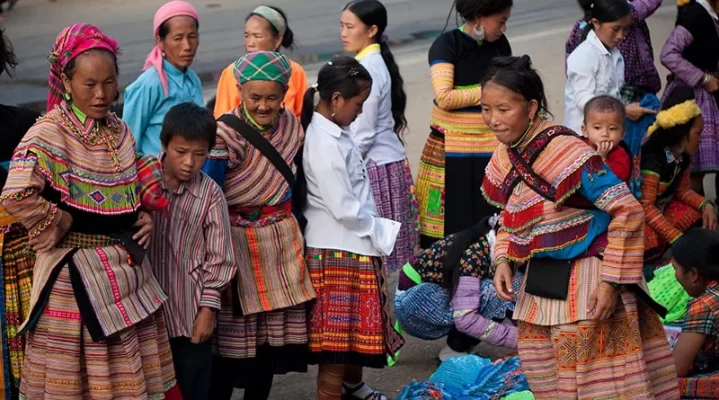
H’Mong people
- H’Mong: The H’Mong people are known for their vibrant traditional clothing, intricate silver jewelry, and lively festivals. Their terraced rice fields and corn plantations define much of the region’s agricultural landscape. The H’Mong language and customs have a profound influence on Meo Vac’s cultural fabric.
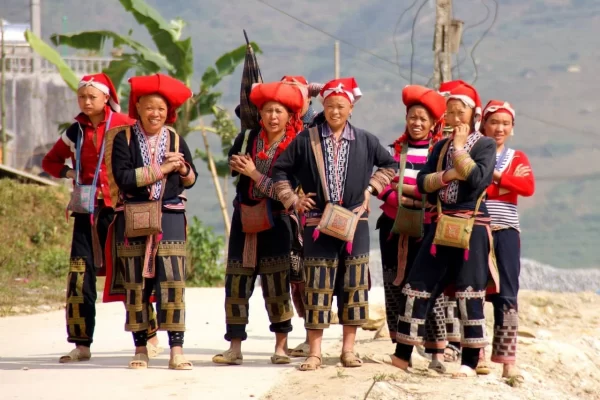
Dao people
- Dao: The Dao people are easily recognizable by their distinctive red headscarves and embroidered garments. They are skilled in herbal medicine and traditional craftwork, particularly embroidery and silverwork. Their homes are often adorned with detailed carvings and symbolic patterns that reflect their spiritual beliefs.
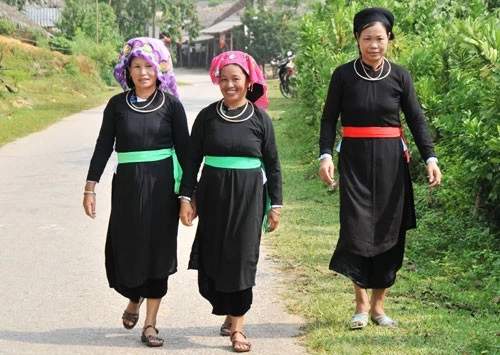
Tay people
- Tay: As one of the largest ethnic groups in northern Vietnam, the Tay people have a rich cultural heritage that includes traditional stilt houses, folk songs, and waterwheel farming. Their cuisine is notable for its simplicity and use of fresh, local ingredients.
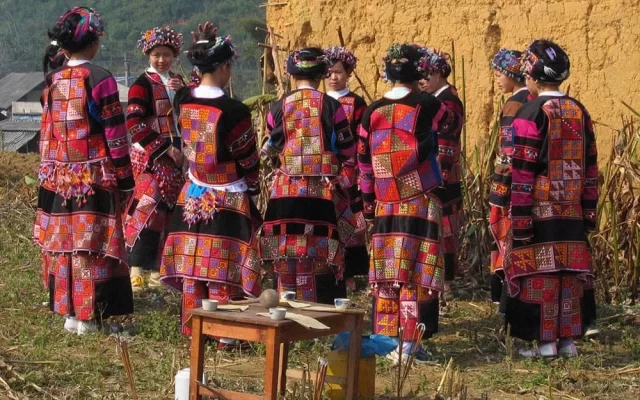
Lo Lo people
- Lo Lo: The Lo Lo people are among the smallest ethnic groups in Vietnam, yet they maintain a strong cultural identity. They are known for their colorful clothing, elaborate headdresses, and unique musical instruments like the bronze drum, which plays a central role in their ceremonies and rituals.
Learn more about: The 5 main ethnic groups in Ha Giang
2. Unique Customs and Traditions
Each ethnic group in Meo Vac brings its own unique customs and traditions, contributing to the area’s rich cultural tapestry.
- Traditional Clothing: The vibrant attire of the H’Mong, the intricately embroidered garments of the Dao, the practical yet stylish clothing of the Tay, and the colorful costumes of the Lo Lo are all integral to their cultural identity. These clothes are often handmade and passed down through generations.
- Agricultural Practices: Many ethnic minorities in Meo Vac engage in terrace farming, which not only supports their livelihoods but also creates stunning landscapes. Each group has developed specialized techniques suited to the mountainous terrain.
- Craftsmanship: Traditional crafts such as embroidery, weaving, and silverwork are highly valued. These skills are often taught from a young age and are crucial for creating traditional attire and household items.
- Social Structure: Villages typically have a strong sense of community, with extended families living close together and supporting each other. Elders play a significant role in maintaining traditions and passing down knowledge.
3. Major Festivals of the Year
The traditional festivals in Meo Vac are vibrant expressions of the ethnic minorities’ cultures, filled with music, dance, and rituals.
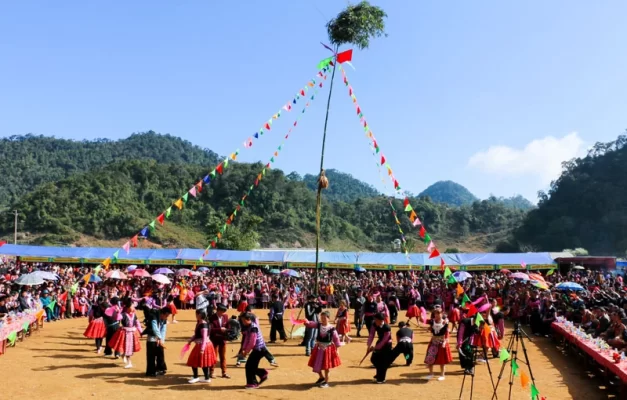
Gau Tao Festival
- Lunar New Year (Tet): Celebrated by all ethnic groups, Tet marks the beginning of the lunar new year with family gatherings, feasts, and traditional games. Homes are decorated, and special foods like sticky rice cakes are prepared.
- Gau Tao Festival: This H’Mong festival is a celebration of health, prosperity, and happiness. It involves a series of rituals, including offering sacrifices to ancestors, traditional music, and dances. The festival also features contests and games that reflect the community’s spirit.
- Cap Sac Ceremony: A significant rite of passage for Dao boys, the Cap Sac ceremony marks the transition to manhood. It involves elaborate rituals, including offerings to ancestors and the wearing of traditional attire. The ceremony is accompanied by feasting and community celebrations.
- Long Tong Festival: Celebrated by the Tay people, the Long Tong festival is a farming ritual that prays for favorable weather and abundant crops. It includes a procession to the fields, offerings to deities, traditional music, and folk dances.
VI. Discover Local Cuisine in Meo Vac Town
1. Outstanding Local Specialties
- Thang Co: Thang Co is a traditional dish of the H’Mong people, made from horse meat, bones, and organs, along with a variety of herbs and spices. This unique dish has a strong, distinctive flavor that adventurous eaters will find fascinating.
- Men Men: Men Men is a staple food for many ethnic minorities in the region, especially the H’Mong. It’s made from steamed ground corn and has a texture similar to couscous.
- Corn Wine: Corn wine is a potent traditional alcoholic beverage made from fermented corn. This local specialty is often homemade and has a distinct, strong flavor. It’s a popular drink during festivals and social gatherings and is known for its warming effect, especially in the cooler mountain climate.
Read more: Ha Giang cuisine
2. The Ideal Places to Enjoy Local Cuisine
- Meo Vac Market: Visiting the Meo Vac Market is a must for food enthusiasts. Here, you can sample a wide array of local street food and traditional dishes. It’s also a fantastic opportunity to interact with local vendors and learn more about the culinary practices of the region.
- Ethnic House: This restaurant provides a cozy setting with a menu focused on the culinary traditions of the region’s ethnic groups. They offer a range of specialties, including grilled meats, soups, and vegetarian options, all prepared with locally sourced ingredients.
- Meo Vac Central Market Eateries: Around the central market area, you’ll find several small eateries and food stalls serving freshly prepared local dishes. These places are perfect for a quick, authentic meal, allowing you to taste the everyday cuisine of Meo Vac residents.
VII. Homestays in Meo Vac Town
1. Meo Vac Clay House
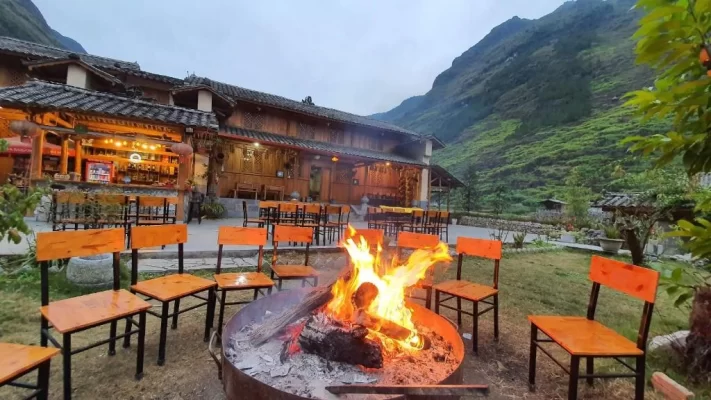
Meo Vac Homestay
- Description: Offers an authentic homestay experience with local H’Mong families.
- Address: Meo Vac Town, Ha Giang Province, Vietnam.
- Price Range: Budget-friendly options starting at $20 per night.
2. Pho Bang Homestay
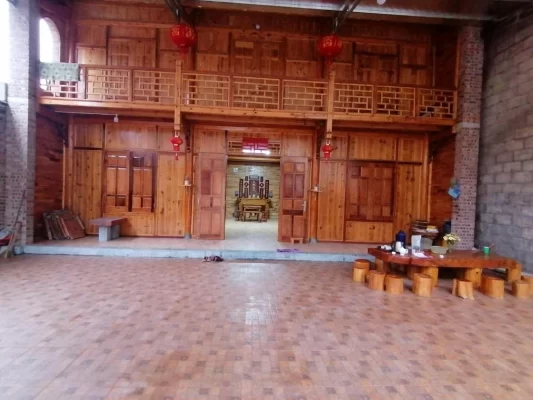
Pho Bang Homestay
- Description: Located in Pho Bang Village, it is known for its historical charm.
- Address: Pho Bang Village, Meo Vac District, Ha Giang Province, Vietnam.
- Price Range: Affordable homestay options start at $15 per night.
3. Dao Lodge Homestay
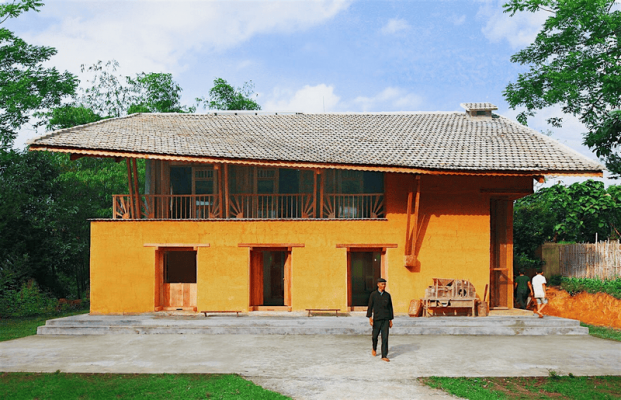
Dao Lodge Homestay
- Description: Eco-friendly lodge nestled in the mountains near Meo Vac.
- Address: Near Meo Vac Town, Ha Giang Province, Vietnam.
- Price Range: Eco-lodge experience with rates starting at $25 per night.
Learn more about: Ha Giang Accommodation
In conclusion, Meo Vac Town offers a unique blend of natural beauty, rich cultural heritage, and authentic experiences that are hard to find elsewhere. From the breathtaking views of Ma Pi Leng Pass to the vibrant local markets, Meo Vac is a destination that promises unforgettable memories. The town’s ethnic diversity adds a fascinating layer to your journey, allowing you to immerse yourself in the traditions and lifestyles of various indigenous communities.
Whether you’re an adventure seeker looking to conquer rugged landscapes or a culture enthusiast eager to explore local customs and cuisine, Meo Vac has something special to offer. Plan your trip to this enchanting town and discover the hidden gems of Northern Vietnam.
See more: Ha Giang travel tips




